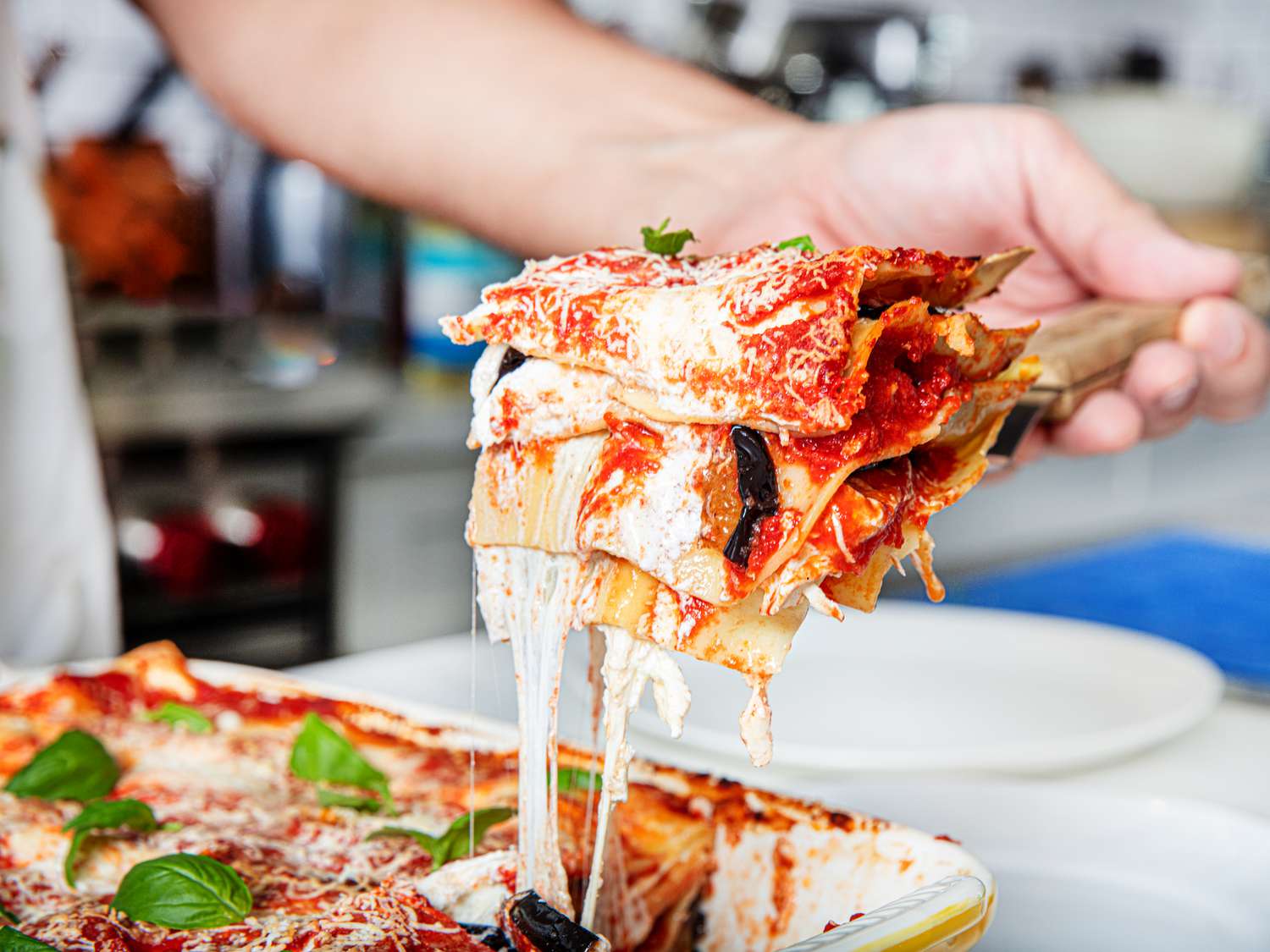
Why It Works
- Salting the eggplant removes water, ensuring a lasagna that’s silky, not wet.
- Blotting the fresh mozzarella and fried eggplant well with towels removes more excess moisture.
- A simple tomato sauce delivers ideal fresh and fruity flavor to the lasagna.
There’s a brief period every year when most of the summer’s best produce overlaps with much of what is to come in the fall and winter. Piles of red tomatoes sit alongside mounds of fresh, crisp apples, and hard winter squash mingle with bell peppers and eggplant. I wouldn’t want to ever have to pick my one favorite time of the year—they all have their place—but if I had to, it’d be hard not to single out this short yet abundant shoulder-season as one of the most glorious.
Serious Eats / Amanda Suarez
This is also a time of year when temperatures drop and cravings for more comforting, filling food hit. In this moment, I can’t think of a better dish to make than lasagna alla Norma, which is an al forno (“baked”) spin on the famous Sicilian pasta featuring summertime stars like eggplant and tomatoes along with fresh dairy such as ricotta or mozzarella (some recipes for this lasagna use one, some the other—I use both). It’s the perfect way to take advantage of the last of summer’s produce in a way that feels suited to the fall.
While this recipe is commonly known as lasagna alla Norma (or lasagna alla Catanese, after the city of Catania where alla Norma is said to originate), I find it just as useful to think of it as a mashup between eggplant Parmigiana and lasagna, given its alternating layers of fried eggplant, tomato sauce, cheese, and pasta. On a technical level, this Parmigiana mindset is more useful in determining the best way to make the dish.
Serious Eats / Amanda Suarez
When I was working years ago on my recipe for Italian-style eggplant parm (melanzane alla Parmigiana), I made it the way I’d learned to make it even more years ago while working on farms in Italy: I sliced fresh summer eggplant, fried it in oil, then layered it with fresh mozzarella, and a simple fresh tomato sauce. It’s my preferred way to make it, much more than the breaded Italian-American version—the result is silky and fragrant, not heavy with breading.
Serious Eats / Amanda Suarez
But over time, some comments popped up on the recipe complaining about a watery result. This stumped me—it’d never happened to me before, not on the farm, and not back at home in New York. Eventually I saw enough comments of this sort that I revisited my recipe and also had it cross-tested by one of my test kitchen colleagues (she reported great results). In the end, I updated the recipe slightly with some small technical adjustments to help reduce potential wetness, all of which I’m applying to this recipe as well. They are:
- Salt the eggplant. My lifelong experience is that most in-season eggplant does not need to be salted. It’s not bitter, which is often given as the reason to salt, and I don’t have any issues with how it cooks when unsalted. But even a brief salting does pull out some of the eggplant’s water, and if wetness was an issue for some cooks at home, it seemed like a logical step to add to my parmigiana recipe, and to this one. Think of it as an insurance policy against unwanted wetness.
- Drain well after frying. This was a step in my original recipe for the parm, but I rewrote the instructions to emphasize how important it is to blot the fried eggplant slices well to remove excess oil. Oil isn’t water, of course, but an abundance of it could in theory give the impression of a too-wet dish.
- Avoid thin tomato sauce. This too was less a technical change to my recipe and more a rephrasing of what was already there, stressing more clearly the importance of using a sauce that is not too thin and watery. It doesn’t have to be thick like tomato paste by any means, but you want a sauce that, while fresh and bright and fruity, is also thick with the fruit’s natural fiber, much like a good apple sauce.
- Blot the mozz. I strongly prefer real, fresh mozzarella to the low-moisture stuff, even though it’s not as good of a melter and can release water when it does melt. It has a clean, milky flavor that comes through in the final dish and significantly improves it, making it miles better than any of the low-moisture mozzarella cheeses that usually get recommended in these kinds of recipes. So, what to do about that wateriness? Simple: I just grab a clean kitchen towel and blot the cheese well to soak up excess water. That seems to do the trick.
With all of the above adjustments, I’m confident my melanzane alla Parmigiana recipe will not come out watery for anyone, and I can say the same for this lasagna, which uses all the same techniques, just with some pasta layered in for good measure.
Serious Eats / Amanda Suarez
The result is fantastic, with flavors and textures that strike as both summery and autumnal at the same time. Though, for all my talk about the seasons, I’ll be honest: I’d happily eat this any time of year.
Trending Products










